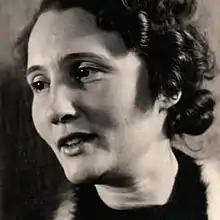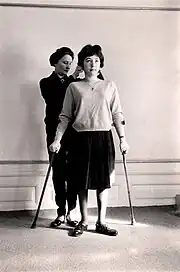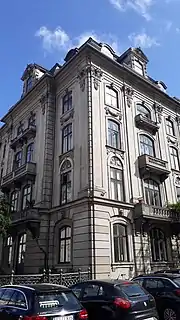Gerda Alexander | |
|---|---|
 | |
| Born | February 15, 1908 Wuppertal, Germany |
| Died | February 21, 1994 Wuppertal, Germany |
| Nationality | German |
| Citizenship | Danish |
| Education | Blensdorfschule für Rhythmik |
| Occupation(s) | Dalcroze euhythmicist, Dalcroze Eurhythmics teacher, Eutony creator |
| Known for | Psychosomatics, body awareness, neuromotor rehabilitation, neuromuscular tone regulation, neuropsychological bases of human movement, expressivity studies, artistic development, somatic practices creation |
Gerda Alexander (February 15, 1908 – February 21, 1994) was a German/Danish Dalcroze eurhythmicist and teacher, and later creator of Eutony. She was involved with the vanguards of the arts, education, and movement culture in Germany in the first decades of the 20th century, and established herself in Denmark in 1929 onwards. Through the creation of Eutony, Gerda Alexander collaborated with medical centers, pedagogical and artistic training institutes in Europe, North and South America and the Middle East.
Gerda Alexander was a pioneer among the creators of somatic education practices in the world. Her school in Copenhagen trained professionals for 45 years, and Eutony is currently taught in professional training schools in Europe and South America.
Life and work
Early life and education
Gerda Alexander was born in Wuppertal, Germany, and her parents were enthusiasts of Dalcroze Eurhythmics, passing on to her a similar interest in the arts. Her parents avoided telling her explicitly about Dalcroze, but Gerda Alexander had her first contact with his work through some photos of the first festival of the Dalcroze school in Hellerau,[1] followed by a Rhythmics course given by Otto Blensdorf in her city in the same period, and insisted on joining the classes.[2]
She attended the Dalcroze Eurhythmics school of Otto Blensdorf (the Blensdorfschule für körperlich-musikalische Erziehung, lately named as Blensdorfschule für Rhythmik) in Wuppertal from 1915 until 1929. From 1922, at the age of 14, Gerda Alexander began to get involved in the activities, trips, stage productions and as an assistant teacher at Blensdorf's school and its affiliates in Essen, Düsseldorf, Köln, Remscheis, Solingen, etc. Around 1923, Gerda directed her first play open to the public, staging the first two acts of Humperdinck's Hänsel and Gretel. In 1924, Otto Blensdorf opened the Blensdorf-Schule (Dalcroze Seminar) für professionellen Rhythmik-Unterricht, a professional training for those who were interested in becoming Dalcroze Eurhythmics teachers, thus providing the pedagogical foundations of the method. Gerda Alexander was part of the first intake of the Seminar.

Through her early experiences, Gerda Alexander got in touch with the development of the modern dance in Germany. She performed in the local theatre in Wuppertal (at that time, known as the Vereinigten Stadttheatern Barmen-Elberfeld) and in international congresses through the country in the 1920s (e.g. GESOLEI). In later interviews and remembrances, Gerda Alexander referred to personalities as Rudolf Laban, Mary Wigman, Elsa Gindler, Heinrich Jacoby, Bess Mensendieck, Loheland school (Louise Langgaard e Hedwig von Rohden) and Anna Herrmann, and highlighted how the observation of their students were important on the development of her work.[3]
Two of Gerda Alexander's teaching internships were remarkable. In 1926, Otto Blensdorf's oldest daughter and collaborator, Charlotte Blensdorf, was invited to teach Dalcroze Eurythmics for children and teachers at the first Institute for Scientific Pedagogical Research under the leadership of Peter Petersen, internationally known for the Jena-Plan. At the same period, Charlotte was also invited by the state government to teach at the Staatlichen Erziehungsheimen Stadtroda, a residential institution that cared for around 600 children and adolescents up to the age of 21 with physical disabilities, mental disorders, children of single mothers, prostitutes or mothers aged 13 or 14, including those from dysfunctional homes and with a criminal record in the city of Stadtroda. Gerda Alexander completed a year of practical work as Blensdorf's assistant in these experiences between 1926 and 1927, to which she refers as being "the best pedagogical education of my life, being able to come into contact with all these cases, with the guidance of teachers who have profoundly influenced my work".[2]
Between the ages of 15 and 21, Gerda Alexander had several severe attacks of rheumatic fever, followed by heart diseases and culminating in an endocarditis, which was considered a disabling illness in the 1920s. She was hospitalized many times and had to find ways to move that would not overload her circulatory system.
Gerda Alexander graduated as a Dalcroze Eurhythmics teacher from the Hochschule für Musik in Berlin in 1929. During this period, Dalcroze Eurhythmics was taught in all large universities and music schools in Germany due to Kestenberg-reform.
Career Milestones
After attending the fifth international conference of the New Education Fellowship (founded by Beatrice Ensor), and then being invited to teach at Fröbel schools, Gerda Alexander moved to Denmark. Her early partnerships also included works in Sweden, most notably at the Royal Conservatory in Malmo, Sydsvenska Gymnastikinstitutet, Ericastiftelsen and the Karolinska Institutet. She maintained a link with her homeland, and attended courses at the Schlaffhorst-Andersen (or Rothenburg) school (1931-1934), attended Charlotte Blensdorf's courses at Landjugendheim Finkenkrug (1932) and in Sternberg (1938) and taught at Dore Jacobs's school in Essen. Gerda Alexander got in contact with Leopold Jessner, former student of Dalcroze and at that time producer and director at the Berliner Staatsoper, to teach movement to all actors and be his director assistant. As he was socialist and Jew, he left Germany when Hitler took power in January 1933 and their partnership had never happened.
Between 1939 and 1940, Gerda Alexander opened a school for Dalcroze Eurhythmics professional teacher training in Copenhagen, the first of its kind to be opened in Denmark. The training was aligned with the principles of the Dalcroze Eurhythmics teaching programmes in England, Switzerland and Germany, and it was partnered with the Royal Danish Conservatory of Music.
With the rise of Nazism and the outbreak of the Second World War, Gerda Alexander remained in Copenhagen for most of her life. By her collaboration in the Danish resistance, she was granted the Danish citizenship in the 1940s.[4]

In 1959, Gerda Alexander organized the "First International Congress for Release of Tension and Functional Movement" in Copenhagen with the support of the Danish Ministry of Education.[5] On this event, she gathered pioneering psychosomatic researchers and methods creators (methods later denominated as "Somatics", "somatic practices" or "somatic education techniques").[6]
Gerda Alexander worked with institutions as diverse as the Fröbel College and Fröbel schools, Malmö Symphony Orchestra, Karolinska Institute, Ericastiftelsen, Frederiksberg Folkemusikhøjskolen, Sydsvenska Gymnastikistitut, Private Theater School, Royal Theatre Copenhagen, Theater Academy, Danish Broadcasting House (orchestra, choir and staff), Royal Music Conservatory, Danmarks Lærerhøjskole (Department of Music), Rigshospitalet, Dalcroze Societies, CEMEA (Centres d'Entraînement aux Méthodes d'Education Active, in France), and others. She gave lectures and workshops in Denmark, Sweden, Norway, France, Austria, Germany, Switzerland, USA, Israel, Greece, Italy, Holland, Mexico, Venezuela, Belgium and Argentina.
Gerda Alexander died six days after her 86th birthday in Wuppertal, where she lived in her old age. Her students today continue to teach her work in several places in the world.
The creation of Eutony
By her ongoing reflections with her students of all ages, an enthusiastic inquiry about artistic development and the overcoming of her difficulties, Gerda Alexander made her own research on human movement. In her own words: "I tried to find out how I could develop every person's own expression without programming him/her. At the same time, there was my personal need to learn how to survive"[3] and "the creation of the principles of Eutony sprang from two important needs within myself. One was to be cured of chronic ailments which orthodox medicine was unable to treat. [...] My other wish was to develop a new medium for movement expression for opera, drama and dance".[7]

Alexander found ways of somatically modulate and regulate neuromuscular tone. The word "eutony" (from Greek Eu: good – and Latin Tonus: tension, the grade of tension or elasticity of muscle fibers) was coined with the help of the Dr. Alfred Bartussek. According to Alexander, "we use high tonus for effort, and medium tonus or low tonus for rest and sleep. In Eutony, we learn to use the best tonus for the action in question".[3]
In the creation of Eutony, Gerda Alexander was deeply engaged in developing a pedagogical approach that considers the person's own experience as a living body. Eutony is based in a student-centered learning process where sensorial experience and critical reflection are the basis for learning. She postulated that "it is important, in treatment, not to give and do more than is necessary, so that the other can rely on himself. It is not that I am a great master who gives you help. Rather, I can introduce you to my work for your own self-discovery."[8]
The psychosomatic processes initiated by her classes were reported by the students, recognizing benefits in their psychic well-being and in their daily life, and Alexander began to receive medical referrals and make partnerships with medical centers, treating patients that "specialists could not give any hope of improvement" as paraplegic, spastic, amputees, with psychosomatic cases, among others.[9] Scientific theories came a posteriori to support her practices, as she describes "from that time, new finding in neurophysiology have become an important support of our work, and our practical discoveries can be explained step by step".[1]
The Gerda Alexander School

The Eutony professional training includes: Eutony (practice and theory, pedagogy and therapy), speech training, psychology, anatomy, physiology, neurology, neurophysiology, neuropathology, psychiatry and seminars from visiting specialists about current development in neurophysiology and other relevant disciplines.
Gerda Alexander opened her school in Copenhagen in 1939/1940 for teacher training in Dalcroze Eurhythmics. In 1943, Gerda Alexander changed the programme to a three-year training course for afspændingspædagoger (teachers/pedagogues of release of tension). In 1957, the school in Copenhagen got state technical college recognition, with a three to four years training with diploma. As she started to use the word "Eutony" to describe her work, the diploma was referred to as "Eutony teachers/pedagogues" and later "Eutonists". It was officially closed in 1987 by the name of "The Gerda Alexander School – International Centre of Eutonia".
Gerda Alexander's book and translations
- Alexander, Gerda (2011). Eutonie - Ein Weg der körperlichen Selbsterfahrung (10th ed.). Bern: Verlag Hans Huber. - edited and supplemented by Karin Schaefer
- Alexander, Gerda (1985). Eutony; The holistic discovery of the total person. Translated by Gerda Alexander. New York: Felix Morrow.
- Alexander, Gerda (2019). L'eutonie: Un chemin de développement personnel par le corps. Bernard Giovanangeli Editeur.
- Alexander, Gerda (1998). La Eutonia - Un camino hacia la experiencia total del cuerpo. Translated by Ana Rodriguez Leonor Spilzinger. Barcelona: PAIDOS IBERICA.
- Alexander, Gerda (1983). Eutonia - Um caminho para a percepção corporal. Translated by José Luis Mora Fuentes. São Paulo: Martins Fontes.
References
- 1 2 ALEXANDER, Gerda (1985). Eutony - The Holistic Discovery of the Total Person. Great Neck, New York: Felix Morrow Publisher. ISBN 9780961565909.
- 1 2 GAINZA, Violeta de (1997). Conversas com Gerda Alexander: Vida e Pensamento da Criadora da Eutonia (in Portuguese). Translated by CARVALHO, Cintia Avila de. São Paulo: Summus Editorial. ISBN 85-323-0560-1.
- 1 2 3 BERSIN, David (1995). "Interview with Gerda Alexander". In JOHNSON, Don Hanson (ed.). Bone, Breath and Gesture: Practices of Embodiment. Berkeley: North Atlantic Books. ISBN 9781556432019.
- ↑ DELAGE, Jessie (2018). Entretiens de Talloires sur l'Eutonie avec Gerda Alexander, août 1986 (in French). France: Ed. Jessie Delage. pp. 62–64.
- ↑ "Foreningen af Eutonipædagoger". Retrieved 10 March 2021.
- ↑ OLIVEIRA, Débora (2023). "A Somatic Meeting in the 1950's? An overview of the First International Congress of Release of Tension and Re-Education of Functional Movement". Journal of Dance and Somatic Practices. in press.
- ↑ ALEXANDER, Gerda (1985). "Eutony and Artistic Expression". Eutony - The Holistic Discovery of the Total Person. Great Neck, New York: Felix Morrow Publisher. ISBN 9780961565909.
- ↑ Reza Leah Bat Pinchas. (January–February 1986). ""The Energy is in the Bones": Eutony's Gerda Alexander". Yoga Journal (66): 21–24.
- ↑ Gainza, Violeta de (1997). Conversas com Gerda Alexander – Vida e Pensamento da Criadora da Eutonia (in Portuguese). São Paulo: Summus Editorial. p. 82. ISBN 85-323-0560-1.
External links
- Original photos: Gerda Alexander (Danish or German descriptions)